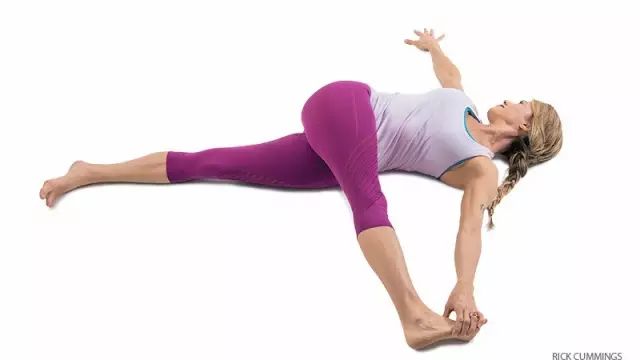Yoga is not on the way to yoga, or on the way to yoga
. 
In yoga classes, we always hear teachers tell us how to protect our knees
. 
For example, in standing pose, the knee bend is not less than 90 °, or if you feel knee pain, withdraw from the pose
. 
Strengthen your quadriceps and lift your knees
. 
These commands are important because knee pain – starting with the patella (kneecap) – is common and repair is slow
. 
However, these instructions are not really focused
. 
It is important to protect the knee, hip abductor and hip muscles
.
Because the traditional way to treat anterior knee pain is to focus on strengthening the deep quadriceps femoris, that is, the medial oblique femoris
.
When this muscle is weak, the kneecap will not be in the correct position, resulting in injury
.
Interestingly, the new study found that strengthening the core, hip abductor and hip muscles, combined with the stretching of quadriceps femoris, can more effectively alleviate knee pain, rather than simply strengthening the medial oblique femoris
.
To understand how these muscles affect the knee, think of the knee in the middle of the whole leg, below the pelvis
.
The kneecap is a movable bone between the foot and the pelvis
.
Any instability of the foot and pelvis will affect the knee
.
When the foot or ankle is unstable, it will bring pain and dysfunction to the knee, as well as the pelvis
.
To stabilize the pelvis, you need a strong core, hip abductor and hip muscles
.
These three muscle groups surround the pelvis
.
If they are stronger, the pelvis will be more stable
.
This is important because there is a small normal rotation of the knee joint when the joint between the femur (thighbone) and the pelvis is flexed and extended
.
However, pelvic instability caused by core, abductor and hip muscles will bring knee pressure and chronic pain
.
For example, the internal rotation of the thigh will turn the knee outward, resulting in pain in the front of the knee
.
Strong hip abductors and external rotation of thigh bones help offset this painful imbalance
.
Of course, it is not enough to focus on stabilizing the muscles of the pelvis
.
The quadriceps femoris is still important
.
You must strengthen the medial oblique (deep quadriceps) and work with stretching, especially the rectus (connecting the hip and knee)
.
When this muscle is too tight – as most people do – the movement of the knee joint is limited and misaligned, resulting in abnormally high-intensity pressure at the joint between the knee joint and the thigh bone
.
However, when you keep that muscle soft and stretched, the knee can move within the normal range
.
The following postures and techniques can help strengthen the core, lateral hip and hip to stabilize the pelvis and relax the quadriceps femoris
.
Give you a pair of healthy, pain free knees
.
The variant of King dance starts with relaxing the quadriceps femoris and strengthening the hip muscles
.
These two muscles are the key to prevent and treat the pain in the front of the knee
.
Use the wall to maintain balance, bend one leg, use the opposite hand to pull the yoga belt, put the yoga belt on the ankle, pull the ankle close to the hip, contract the hip muscles and start the gluteus maximus on the side of the bent leg( Start the hip muscles, rotate the pelvis downward and backward, stretch the rectus femoris, bend the knee and stretch the other three muscles of the quadriceps femoris) for 30 seconds, then change sides, repeat 3 times, 2 supine, grasp the big toe, lift up, twist the variant, stretch and strong abductors, lie down and pull one leg across the body
.
Use the opposite hand or yoga belt to grasp or cover the sidewall of the foot
.
When you feel the stretching of the side of the hip, your legs fight against the hand or yoga belt, as if you want to come out of the pose
.
In this way, the hip abductor can be strengthened
.
At the same time, turn the upper leg outward slightly, start the quadriceps femoris, including the rectus femoris, straighten the leg, lift the knee up to the correct position for 30 seconds, and then change the sides
.
Repeat for 3 times
.
The warrior can strengthen the hip muscle of the rear leg in one form, and stabilize the hip and ankle of the front leg
.
In order to protect the front side of the knee, Bend the front legs slowly and work towards 90 °, not less than 90 °, press the foot ball of your feet and the outside down, you can stabilize your legs and lift the foot arch
.
When you straighten the back legs, you can start the hip muscles
.
Slightly pull the back foot close to the midline, and insert the thigh bone of the leg in front of the midline back into the hip joint slot to help stabilize the knee joint in the right position, strengthen the muscles around the hip, improve your awareness of the joint position, maintain it for 30 seconds, then change sides and repeat these postures for 3 times
.
You can strengthen the leg muscles and stabilize the knee
.
The knee bone is fragile, or you have felt the knee For friends with ankle pain and instability, you can practice more
.
The practice is mainly gentle, don’t use brute force, and pay close attention to the feeling of the knee
.
▼ teacher wechat ▼ recent good Wen ▼ today’s Yoga people are watching.
.

